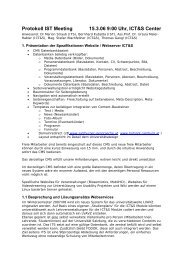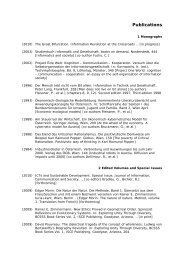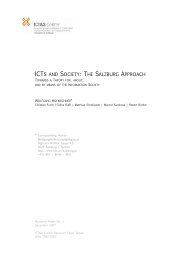CHRISTIAN FUCHS - ICT&S - Universität Salzburg
CHRISTIAN FUCHS - ICT&S - Universität Salzburg
CHRISTIAN FUCHS - ICT&S - Universität Salzburg
Create successful ePaper yourself
Turn your PDF publications into a flip-book with our unique Google optimized e-Paper software.
Christian Fuchs: Social Networking Sites and the Surveillance Societyadvertising clients for “business reasons”. This means that in such cases companies areallowed to send advertising messages per email to MySpace users. MySpace is allowedto disclose personal information of its users to law enforcement agencies.9.2. Research MethodWe conducted an empirical case study on the relationship of surveillance society andISNS usage by students in <strong>Salzburg</strong>. The research was carried out from October toDecember 2008. The questionnaire was available for 50 days to the students. Weconstructed a questionnaire that consisted of 35 (single and multiple) choice questionsand 3 open-ended questions, and 5 interval-scaled questions. The questionnaire wasimplemented as an electronic survey with the help of the online tool Survey Monkey.702 respondents participated in the survey. 28 datasets were deleted from the datasetbecause the respondents indicated that they were no students or former students andthe study focuses on academic usage of ISNS. The remaining N=674 datasets wereanalyzedMost of the respondents are heavy users of integrated social networking sites (ISNS).39.3% use such platforms several times per day, 22.8% once a day (figure 10). So62.1% of the respondents use ISNS at least once a day.52.3% of the respondents read the terms of use of ISNS in detail or almost entirely,47.7% read them only partly, superficial, or never. This shows that informationbehaviour concerning interest in what Internet companies are allowed to do with userdata is almost equally split between a group that rather cares and a group that rathernot cares.9.3. Surveillance Knowledge and Critique of SurveillanceA surveillance knowledge index was calculated by combining the answers to severalquestions that tested this knowledge. 16.5% (0 correct answers) of the respondents haveno, 65.3% (1 correct answer) little, 16.5% (2 correct answers) average, and 1.8% (3correct answers) high knowledge of surveillance. The median of the surveillanceknowledge index is 1 (little knowledge of surveillance).Bivariate correlations between the surveillance knowledge index and other factorsshow that the surveillance knowledge index is significantly (at the 0.01 level) negativelycorrelated to female gender (positively to male gender) and the white-collar status of astudent’s father. It is significantly (at the 0.01 level) positively correlated to the status ofa student’s father as househusband, income, and the size of the location that thestudents have been living in for most of their lifetime. The analysis shows overall thatgender and class and the urban/rural-differential are three factors that influencesurveillance knowledge.We combined the answers to five scaled questions to an overall index (surveillancecritique index). The statistical average of this index is 17.3 (scale: 0-25, 0=no critiquetowards surveillance, 25=high level of critique towards surveillance) (N=613). Thisindicates a rather critical stance of the students in our sample towards surveillance.110









